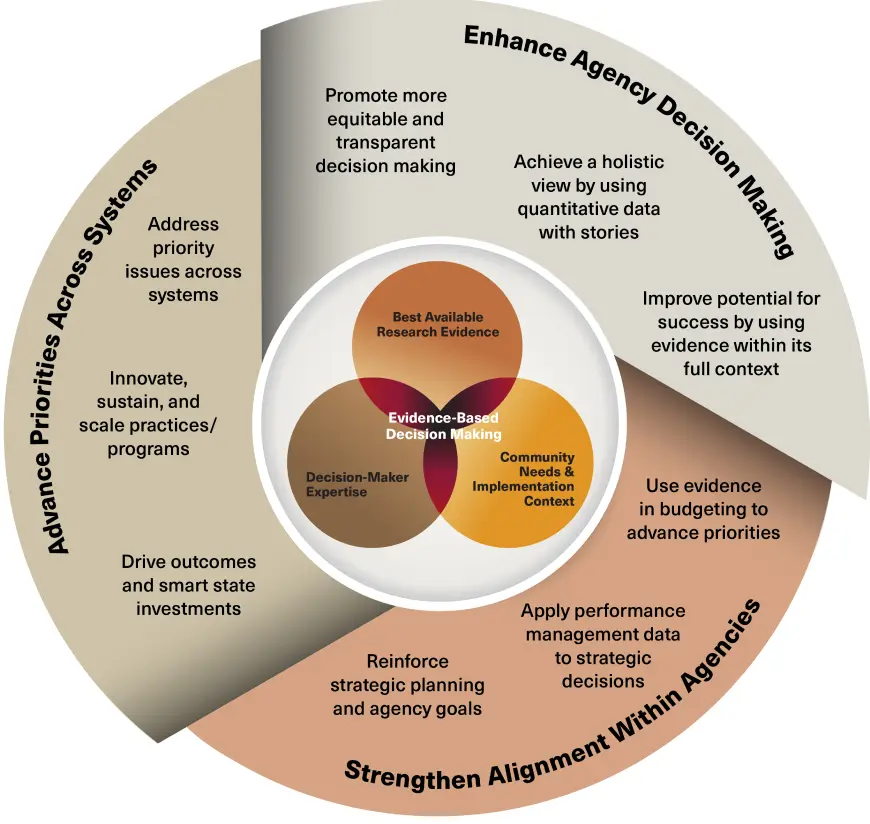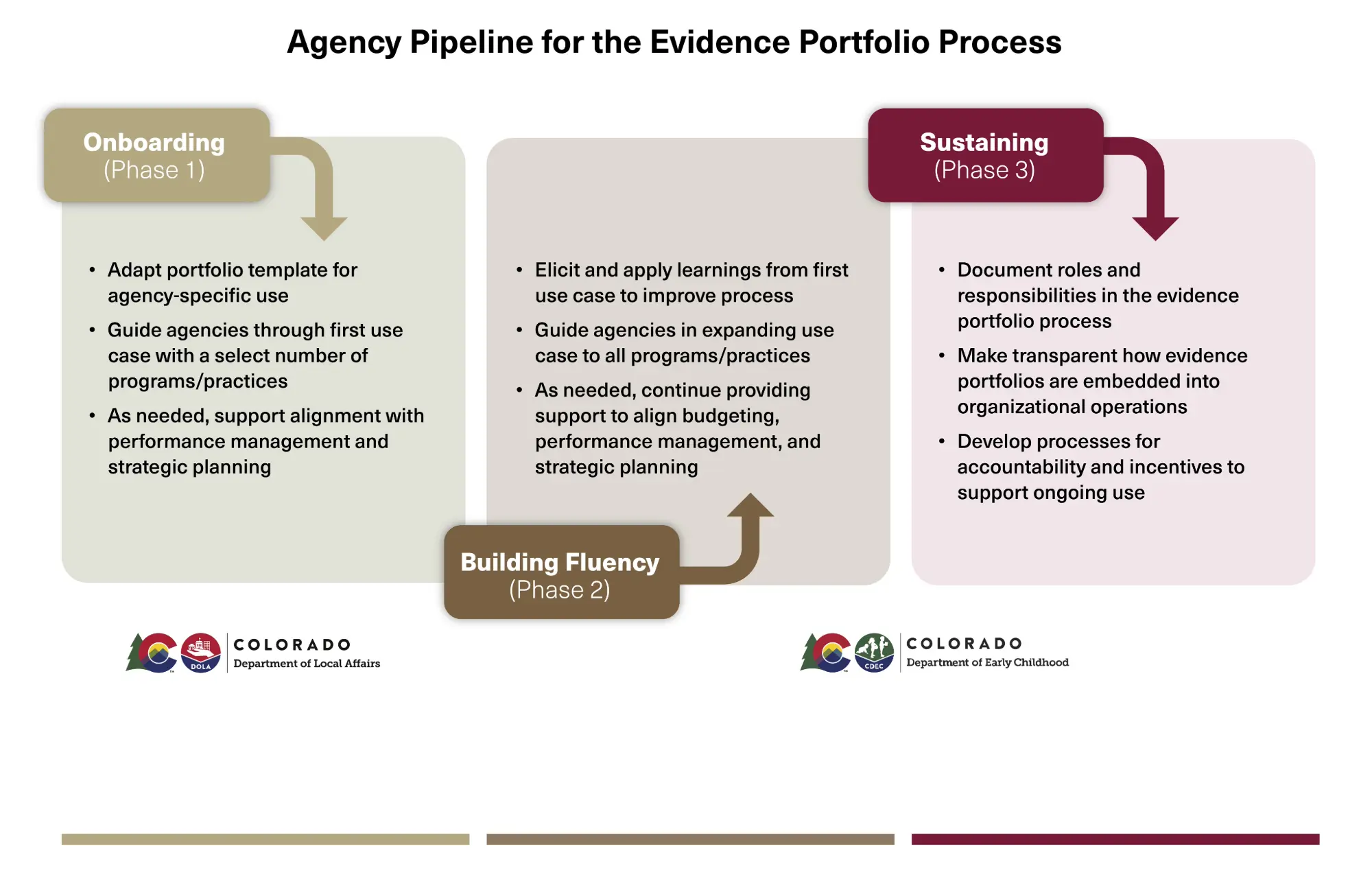Goal 2 Overview
Equip state agencies with tools to embed evidence-based decision making in their budgeting process and align structures in the budget cycle across executive and legislative branches.


Goal 2 Activities
State agencies have expressed a need for support in using data to inform budget and policy priorities. In response, the Colorado Lab developed the evidence portfolio process, a three-phased pipeline that supports agencies in adopting an EBDM approach. The focus is on the development of organizational theories of change, program inventories, and Evidence Portfolios for each program or practice. A completed evidence portfolio tells the story of impact and identifies opportunities for strengthening and scaling the program or practice. The process uses a set of criteria tied to the three major domains of evidence-based decision making: best available research evidence, community needs and implementation context, and decision-maker expertise. Through structured tools and guidance, the process is facilitated by the Colorado Lab and graduates agencies over the three phases toward independence and sustainability. The evidence portfolio process is based on literature and tools from implementation science and evidence-based policymaking.
The evidence portfolio process is an internal mechanism for agencies to systematically engage in evidence-based decision making and build capacity for making data-informed policy, budget, implementation, and evaluation decisions. The evidence portfolio process is aligned with budget instructions from the Governor’s Office, and with definitions of evidence from HB24-1428, to support continuity across the budgeting process.
Pipeline for Replicating Use of the Evidence Portfolio Process Across State Agencies
The three-phased pipeline typically takes multiple years to fully scale. An agency may move through a given phase in the pipeline within one budget cycle, or may need multiple budget cycles to fully accomplish a phase. This depends on factors such as capacity, complexity of organizational structure, and size of budget, among other things.

The Colorado Lab developed the evidence portfolio process in 2023 in response to a need at the Colorado Department of Early Childhood (CDEC). CDEC wanted a decision-making process for prioritizing the continuation of stimulus-funded activities that would otherwise end with COVID-19 relief funding. After testing an early version of the evidence portfolio process on just stimulus-funded activities, they adopted it for all the agency’s programs and practices during the SFY25 budget cycle. Since then, additional agencies have adopted evidence portfolios with technical assistance from the Colorado Lab. Their logos, included on the graphic above, reflect approximately where each is in the process.

Goal 2 Tools for the Evidence Portfolio Process
Below are four tools that are used to accomplish the evidence portfolio process. Agencies begin the process with the Program/Practice Inventory. Then, they complete the Evidence Portfolio Tool for each program/practice listed in the inventory. The Evidence Portfolio Guidance acts as a technical assistance tool during portfolio completion. The process concludes when results of the Evidence Portfolio for each program/practice are translated to the Systems Map to inform decision making.
Evidence Portfolios for State Agencies, 2-Pager
This two-pager introduces the evidence portfolio process, including its background, value, and structure.
Program/Practice Inventory
The inventory identifies all programs/practices of the agency. It is created once and updated annually. An evidence portfolio is completed for each program/practice.
Evidence Portfolio Guidance
This document accompanies the evidence portfolio tool and provides guidance in completing portfolios for each program/practice.
Evidence Portfolio Tool
Fill out this tool once for each program or practice. Revise the tool at least annually, building on the work you had the year before.
Systems Map
Results and recommendations for all evidence portfolios in the inventory are synthesized. Agency leadership apply a systems lens during decision-making to achieve a balanced view and identity trade-offs and dependencies.
HB24-1428
Bill describing how research evidence should be used to inform funding decisions for programs implemented and delivered by state agencies.
Goal 2 Actionability
Beyond the state budgeting process, agency staff report that evidence portfolios benefit their day-to-day and strategic work. This includes cross-training staff who are otherwise siloed, building cross-agency partnerships, identifying opportunities for continuous quality improvement, and securing grant funding.
Colorado Lab support for replicating the evidence portfolio process across all state agencies follows a pipeline approach (see visual). This approach helps to ensure state agencies receive the technical assistance necessary to a) launch successfully and adapt the tools to their unique context, b) build fluency and embed the work into agency operations, and c) sustain the evidence portfolio process over time. Agencies are prioritized for the pipeline based on select readiness factors, the top of which is whether leadership is poised and willing to embrace the EBDM vision.
Because this is an agency-owned tool to be updated annually, it is critical that agency staff are able to develop content for their portfolios and apply results, independent of external support once initial onboarding and fluency is built. This supports agency capacity building and sustainability.
Get Involved
Contact us to start a conversation about how the Colorado Lab can help your organization get the most out of the evidence portfolio process.
For more information about working with the Colorado Lab, see Government and Community Partnerships or Research Partnerships.
